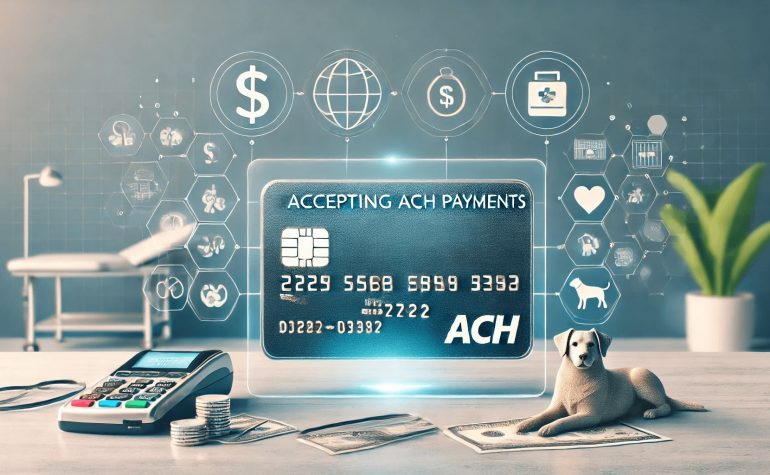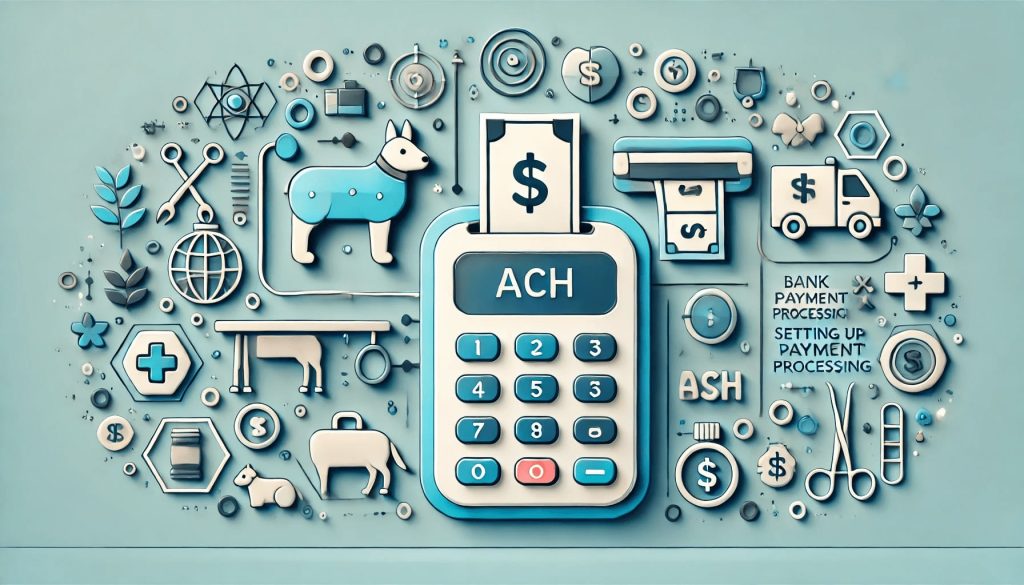
By alphacardprocess October 6, 2024
In today’s digital age, accepting various forms of payment is crucial for businesses to thrive. For veterinary practices, offering convenient payment options is not only beneficial for clients but also helps streamline financial operations. One such payment method that has gained popularity in recent years is ACH (Automated Clearing House) payments.
In this comprehensive guide, we will explore everything you need to know about accepting ACH payments for veterinary businesses.
Understanding ACH Payments: What You Need to Know
ACH payments are electronic transfers of funds between bank accounts. Unlike credit card payments, which involve the use of cards and card networks, ACH payments rely on the ACH network to facilitate the transfer of funds. This network connects financial institutions and allows for the secure and efficient movement of money.
To initiate an ACH payment, the payer provides their bank account information, including the routing number and account number, to the payee. The payee then uses this information to electronically debit the payer’s account and credit their own account. This process eliminates the need for physical checks or credit card transactions, making it a convenient and cost-effective payment option for both businesses and customers.
Benefits of Accepting ACH Payments for Veterinary Businesses
- Cost Savings: ACH payments typically have lower transaction fees compared to credit card payments. This can result in significant cost savings for veterinary practices, especially those with a high volume of transactions.
- Faster Payments: ACH payments are processed in batches, usually overnight. This means that funds are transferred more quickly compared to traditional check payments, which can take several days to clear. Faster payments improve cash flow and allow veterinary practices to access funds sooner.
- Convenience for Clients: Many pet owners prefer the convenience of ACH payments. By offering this payment option, veterinary practices can cater to the needs and preferences of their clients, enhancing customer satisfaction and loyalty.
- Recurring Payments: ACH payments are ideal for recurring billing, such as monthly pet insurance premiums or wellness plan payments. By setting up automatic ACH payments, veterinary practices can ensure consistent and timely payments from their clients.
- Reduced Risk of Fraud: ACH payments are highly secure, with built-in authentication measures and encryption protocols. This reduces the risk of fraud and unauthorized transactions, providing peace of mind for both veterinary practices and their clients.
Setting Up ACH Payment Processing for Your Veterinary Practice

To start accepting ACH payments, veterinary practices need to set up ACH payment processing. Here are the steps involved in the process:
- Obtain a Merchant Account: A merchant account is necessary to accept ACH payments. Contact your bank or a reputable payment processor to set up a merchant account specifically for ACH transactions.
- Gather Required Information: To set up your merchant account, you will need to provide certain information, including your business’s legal name, tax identification number, bank account details, and contact information.
- Choose an ACH Payment Provider: Select an ACH payment provider that offers the features and services that align with your veterinary practice’s needs. Consider factors such as transaction fees, customer support, integration options, and security measures.
- Complete the Application Process: Once you have chosen an ACH payment provider, complete the application process by providing the necessary information and documentation. This may include your business’s financial statements, processing history, and any additional requirements specified by the provider.
- Set Up Payment Gateway Integration: If you have an existing practice management software or website, ensure that it is compatible with your chosen ACH payment provider. Integration allows for seamless payment processing and simplifies reconciliation.
- Test and Launch: Before accepting live payments, conduct thorough testing to ensure that your ACH payment processing system is functioning correctly. Once you are satisfied with the results, launch your ACH payment option and inform your clients about the new payment method.
Choosing the Right ACH Payment Provider for Your Veterinary Business
Selecting the right ACH payment provider is crucial for the success of your veterinary practice. Here are some factors to consider when choosing a provider:
- Transaction Fees: Compare the transaction fees charged by different ACH payment providers. Look for providers that offer competitive rates and transparent pricing structures.
- Integration Options: If you already have a practice management software or website, ensure that the ACH payment provider can integrate seamlessly with your existing systems. This will save you time and effort in reconciling payments and managing your financial records.
- Security Measures: Data security is of utmost importance when it comes to processing payments. Choose a provider that employs robust security measures, such as encryption and tokenization, to protect sensitive information.
- Customer Support: Look for a provider that offers reliable customer support. In case of any issues or questions, prompt and knowledgeable assistance can make a significant difference in resolving problems quickly and efficiently.
- Reporting and Analytics: Consider providers that offer comprehensive reporting and analytics tools. These features can provide valuable insights into your veterinary practice’s financial performance and help you make informed business decisions.
Step-by-Step Guide to Accepting ACH Payments in Your Veterinary Practice
Now that you have set up your ACH payment processing, it’s time to start accepting ACH payments in your veterinary practice. Follow this step-by-step guide to ensure a smooth transition:
- Educate Your Staff: Train your staff on the process of accepting ACH payments. Make sure they understand how to guide clients through the payment process and address any questions or concerns.
- Update Payment Policies: Review and update your payment policies to include ACH payments. Clearly communicate the terms and conditions associated with ACH payments to your clients, including any fees, refund policies, and payment deadlines.
- Promote ACH Payments: Inform your clients about the availability of ACH payments. Utilize various communication channels, such as your website, social media platforms, email newsletters, and in-clinic signage, to spread the word.
- Provide Clear Instructions: Create user-friendly guides or videos that explain how clients can set up and initiate ACH payments. Include step-by-step instructions and screenshots to make the process as straightforward as possible.
- Offer Incentives: Encourage clients to choose ACH payments by offering incentives, such as discounts or rewards. This can motivate them to switch from other payment methods and experience the benefits of ACH payments.
- Monitor and Optimize: Regularly monitor your ACH payment processing system to ensure smooth operations. Analyze transaction data and identify any areas for improvement or optimization. Continuously refine your processes to enhance efficiency and customer satisfaction.
Ensuring Security and Compliance with ACH Payments in Veterinary Businesses
Security and compliance are paramount when it comes to accepting ACH payments in veterinary businesses. Here are some best practices to ensure the safety of your clients’ information and maintain regulatory compliance:
- Encryption and Tokenization: Implement encryption and tokenization technologies to protect sensitive data during transmission and storage. Encryption converts data into unreadable code, while tokenization replaces sensitive information with unique tokens, reducing the risk of data breaches.
- Secure Network Infrastructure: Maintain a secure network infrastructure by regularly updating software, firewalls, and antivirus programs. Use strong passwords and multi-factor authentication to prevent unauthorized access to your systems.
- PCI Compliance: If you accept credit card payments alongside ACH payments, ensure that you comply with the Payment Card Industry Data Security Standard (PCI DSS). This standard outlines security requirements for businesses that handle credit card information.
- Employee Training: Train your staff on data security best practices, such as recognizing phishing attempts, handling sensitive information, and following proper protocols for data storage and disposal. Regularly reinforce these training sessions to keep security top of mind.
- Regular Audits and Assessments: Conduct regular audits and assessments of your ACH payment processing system to identify any vulnerabilities or compliance gaps. Engage third-party security experts to perform comprehensive assessments and provide recommendations for improvement.
Common Challenges and Solutions for ACH Payments in Veterinary Practices
While accepting ACH payments offers numerous benefits, veterinary practices may encounter certain challenges along the way. Here are some common challenges and their solutions:
- Client Education: Some clients may be unfamiliar with ACH payments or have concerns about security. Address these concerns by providing clear and concise educational materials, such as FAQs and step-by-step guides, to help them understand the process and alleviate any doubts.
- Payment Reversals: ACH payments can be reversed in certain circumstances, such as when a client disputes a transaction or if there are insufficient funds in their account. Establish clear policies and procedures for handling payment reversals to minimize any potential disruptions or financial losses.
- Integration Issues: Integrating your ACH payment processing system with existing software or websites can sometimes present technical challenges. Work closely with your payment provider and software developers to ensure seamless integration and resolve any compatibility issues.
- Compliance Requirements: Veterinary practices must comply with various regulations, such as the Health Insurance Portability and Accountability Act (HIPAA) and the Fair Credit Reporting Act (FCRA). Stay updated on the latest compliance requirements and work with legal and compliance experts to ensure adherence.
Frequently Asked Questions
Q.1: Are ACH payments secure?
Yes, ACH payments are highly secure. They utilize encryption, tokenization, and authentication measures to protect sensitive information and prevent unauthorized access.
Q.2: How long does it take for ACH payments to clear?
ACH payments typically clear within 1-2 business days, although the exact timeframe may vary depending on the financial institutions involved.
Q.3: Can I set up recurring ACH payments for my clients?
Yes, ACH payments are ideal for recurring billing. You can set up automatic payments for services such as pet insurance premiums or wellness plan payments.
Q.4: Can I accept ACH payments through my website?
Yes, many ACH payment providers offer website integration options. Consult with your payment provider or web developer to enable ACH payments on your website.
Q.5: What fees are associated with ACH payments?
Transaction fees for ACH payments are typically lower compared to credit card payments. The exact fees may vary depending on your chosen payment provider and the volume of transactions.
Conclusion
Accepting ACH payments can bring numerous benefits to veterinary businesses, including cost savings, faster payments, convenience for clients, and enhanced security. By following the step-by-step guide outlined in this comprehensive article, veterinary practices can successfully set up and integrate ACH payment processing, ensuring a seamless payment experience for their clients.
Remember to prioritize security and compliance, address common challenges, and continuously optimize your processes to maximize the advantages of accepting ACH payments.